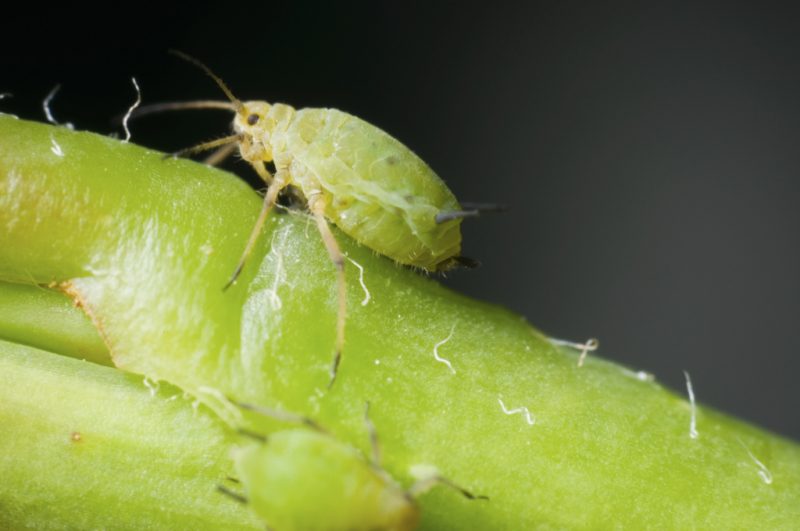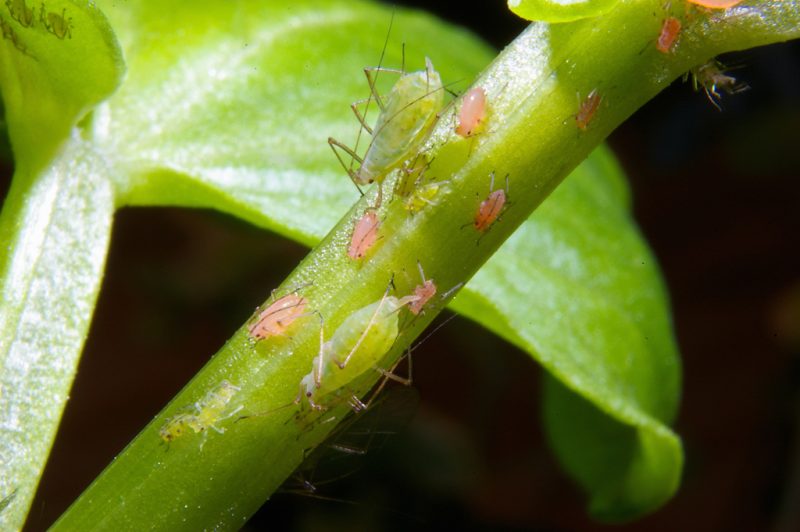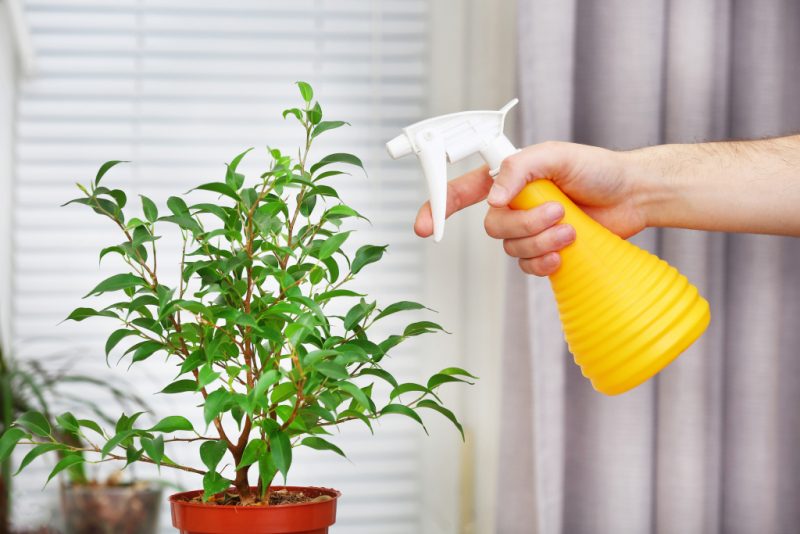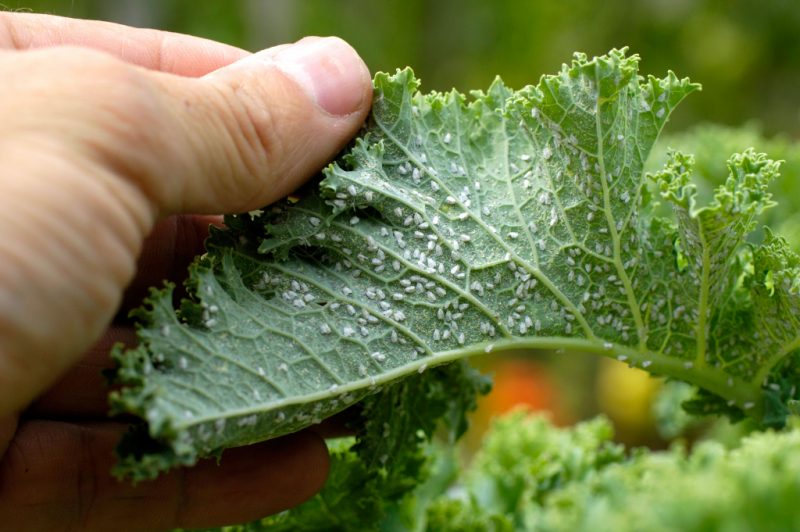Pests and diseases overshadow the joy of caring for flowers, vegetables, fruit trees and shrubs. Often attacks aphid plants - an almost omnivorous insect. A simple method of control is washing the leaves, and with severe infection, the use of insecticides is required.
Material Content:
Reasons for the appearance
Pests enter the premises from the outside: with bouquets, purchased indoor flowers, seedlings, vegetables or fruits. Eggs, larvae and adults are stored in soil from the field, from the garden or store. The reason for the appearance of aphids on healthy plants can be animals and people. Insects are transferred to new habitats with clods of land and parts of plants on wool, paws, clothes and shoes.

The pest is omnivorous, which allows it to settle and survive without problems in a collection of indoor flowers, in a flower bed or in a garden.
At first, aphids on indoor plants remain invisible. Larvae and wingless females slowly crawl in search of a better place for feeding, and multiply rapidly. If succulent shoots are lignified or the host plant is overpopulated, then winged aphids are born. They fly long distances, rise in height, are carried by the wind to balconies, loggias, and enter rooms through windows and doors.
Symptoms of plant aphid damage
Insects of this group belong to the order of the semi-rigid winged family, the family of true aphids. The body has an oval or teardrop shape, reaches a length of 1-5 mm. Coloring - green, gray, brown or almost black, often coinciding with the color of the organ of the plant, which feeds the pest.The oral apparatus, the proboscis, is adapted to suck out juices with amino acids from living tissues.

Common pests:
- on fruit and berry plants - cherry, green peach, green apple, gelichrysum, redcurrant, gooseberry, apple-cereal aphid;
- on vegetables - melon, large potato, hawthorn, pea, cabbage, green peach, beet aphid;
- on indoor flowers - green peach, beet, hawthorn, large potato aphids.
Females can be winged and wingless. The second breeds parthenogenesis (without fertilization). One female produces 3 generations of young animals per month. Often colonies of sedentary aphids in a continuous layer cover the skin of young shoots and buds. Insects can damage the bulbs, the lower parts of the stems.

Affected organs are deformed and dry out, flowers, ovaries crumble. Sometimes at the place of parasitism there are growths - galls.
Aphids secrete a sugar solution - pad or honey dew. The liquid spreads over the surface of the leaves, makes gas exchange difficult, creates a breeding ground for the soot fungus. Sweet secretions attract ants. Buds glued with a pad do not bloom, young shoots, leaves curl.
It is important not to miss the moment of the appearance of aphids, not to postpone the beginning of the fight in a long box. If you do not stop the spread of the colony, then all the plants in the room, on the balcony or terrace, in the greenhouse and greenhouse will be affected. It is possible to create conditions for suppressing the life of pests, to fight using various methods with minimal use of chemicals.
How to get rid of a pest on indoor plants

Aphids can be recognized by the shiny traces of secretions, black spots of soot fungus, clusters of small insects on the underside of leaves. A small colony will disappear if the affected parts (shoots, leaves, buds, flowers) are cut off in time, and the insects are washed off in the shower.
Folk remedies
Aphids or other small sucking insects on indoor plants can be destroyed by washing with soap and water. Infusions or decoctions of herbs are used to spray and treat the leaves with a cotton pad, soft brush. If the affected shoots are thin, delicate, then after 15 minutes rinse them with clean water.

How to get rid of aphids on indoor plants using folk remedies:
- Boil 50 g of crushed hot pepper in 0.5 l of water for an hour, insist for a day, then filter; dilute 10 g of this concentrate in 1 l of water, add 4 g of laundry soap for better “sticking”.
- Insist 10 g of dry tobacco dust in 1 liter of water for a day; filtered, added to 1 part of the concentrate 3 parts of water, laundry soap (10 g per 1 l).
- Mix 500 g of pine needles and 2 liters of water, insist 6-7 days, before spraying, dilute with clean water 7 times.
- Dried, crushed leaves of tomatoes fill the jar, pour water for 2-3 hours, and then filter.
- Insist day 1 tsp. finely chopped onion or ½ tsp. crushed garlic in 250 ml of water (under the lid).
- Mix 1 cup of wood ash, 20 g of laundry soap in 5 l of water.
- Dissolve 1 tbsp. l soap in 1 liter of water, add 1 tbsp. l moonshine.
The filtered solution is used to fill the flask of a sprayer, sprayer or atomizer for indoor plants. The affected leaves, stems, buds and flowers are treated. If the mixture is too thick and concentrated, then diluted with water.
Plus folk remedies - relative harmlessness for people and pets. However, some time after the application of the solution, insects may reappear. Therefore, the treatment must be repeated 3-4 times.
Chemical aphids
The high fecundity and omnivorousness of insects makes it difficult to combat them. With a significant amount of aphids on plants in the room, insecticides are used.The first time they are sprayed with one agent, after a week the treatment is repeated, but another chemical is used.

The names of drugs to combat aphids:
- Confidor Extra;
- Fitoverm;
- Actara;
- Zolon.
Biological products are the least dangerous for humans and pets. Fitoverm refers to biopesticides of intestinal and contact action. The drug destroys insect pests, including aphids. Dosage: 1 ampoule per 250 ml of water. If necessary, combine with pyrethroids in a ratio of 1: .1, with fertilizer for foliar top dressing. During spraying, you can not take plants out of the room to fresh air.
The active substance aversectin C penetrates through the integument of the body of the insect and enters the intestine when the treated plant is eaten. Aphids lose their ability to feed after 10-15 hours. Paralysis and death of pests occurs on the third day. The solution does not affect the eggs. Fitoverm protects indoor plants from aphids for 2-3 weeks. The effectiveness of the drug on an open balcony in wet weather is lower. Spraying should be repeated after 4–5 days, 4 treatments may be required.
How to get rid of aphids in the garden forever
Thanks to the application and combination of various control methods, it is possible to reduce the number of sprayings with pesticides and reduce the chemical load.
Processing plants from aphids
You can alternate folk remedies and chemicals. It should be remembered that infusions of herbs, pepper or garlic will not help get rid of a large amount of aphids on plants. In such cases, pesticides are used.

Chemicals for the treatment of aphids
| Title | What crops is used |
|---|---|
| Aktara | On currants, gooseberries, tomatoes, cucumbers, peppers, eggplant, cabbage, onions, roses. |
| Decis Profi | On the apple tree. |
| Fitoverm | On seedlings of pepper, tomatoes, eggplant |
Used for spraying infusions of tobacco, garlic, pine needles, tomato tops. One fruit tree will require from 2 to 10 liters of solution, on a berry bush - from 1 to 1.5 liters; on 10 m2 of strawberries, vegetables - 1.5 liters.
Handy ways to get rid
Aphids often winter on apple trees and pears. In spring, the garden and the garden are cleaned of sick and dry plants, mummified or rotting fruits left over from autumn. Any plant debris serves as a place of conservation and reproduction of pathogens and pests. You can shake off insects from shoots on fabric or paper, then destroy.

Aphids feed on about 20 species of arthropods: ladybugs, lacewings, earwigs, carnivorous bugs and flies. Leave along the border or sow chamomile, tansy and yarrow, which serve as a home for a ladybug and lacewing. Other aphid enemies are attracted by crops of dill, mustard, coriander, parsley, celery, caraway seeds, and thyme.
Prevention is the best way to fight
It is necessary to correctly compost, feed the plants, prevent the growth of weeds. Using drip irrigation allows you to direct moisture to the roots of plants, which reduces the risk of transmission of infection and small insects by water flows. Garden tools are recommended to be cleaned and disinfected.
The success of fighting aphids is ensured by a combination of chemicals with biological and mechanical methods. It is necessary to take care of the preparation of the site, properly cultivate the soil, apply crop rotation, use high-quality planting material.












